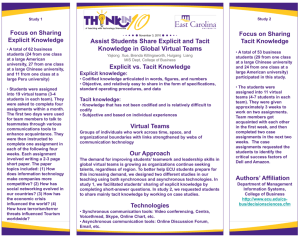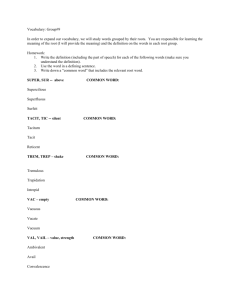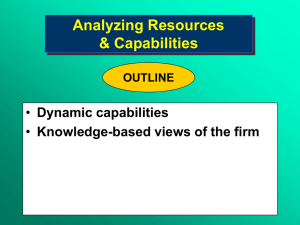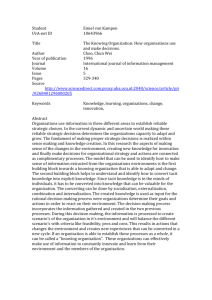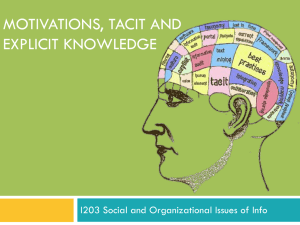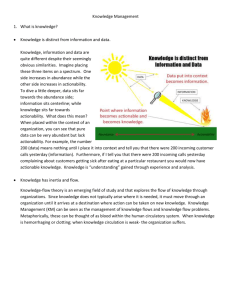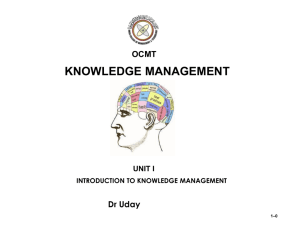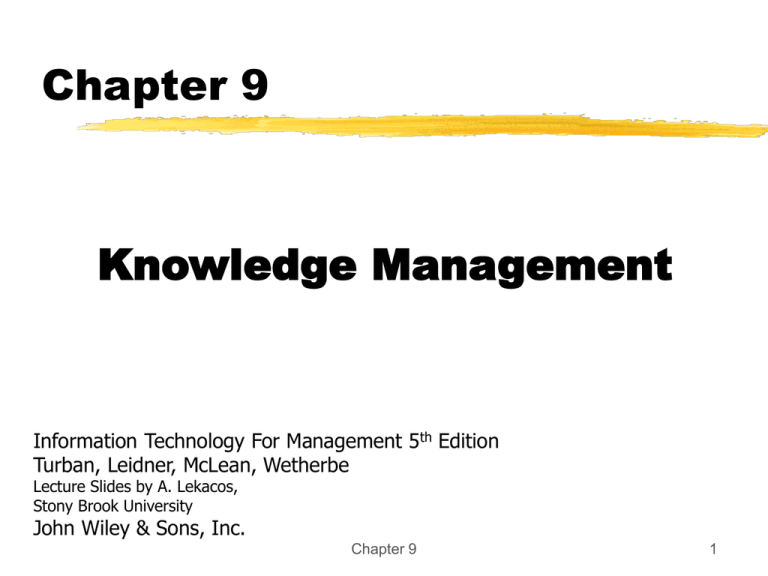
Chapter 9
Knowledge Management
Information Technology For Management 5th Edition
Turban, Leidner, McLean, Wetherbe
Lecture Slides by A. Lekacos,
Stony Brook University
John Wiley & Sons, Inc.
Chapter 9
1
Learning Objectives
•
•
•
•
•
•
•
Define knowledge and describe the different types of
knowledge.
Describe the activities involved in knowledge
management.
Describe different approaches to knowledge
management.
Describe the issues associated with implementing
knowledge management in organizations.
Describe the technologies that can be utilized in a
knowledge management system.
Describe the activities of the chief knowledge officer and
others involved in knowledge management.
Describe benefits as well as drawbacks to knowledge
management initiatives
Chapter 9
2
Knowledge Management
Knowledge management (KM) is a process that helps
organizations identify, select, organize, disseminate, and transfer
important information and expertise that are part of the
organization’s memory.
•
Structuring of knowledge enables
•
•
•
•
effective and efficient problem solving
dynamic learning
strategic planning
decision making.
•
Knowledge management initiatives focus on
•
Knowledge management can
• identifying knowledge
• how it can be shared in a formal manner
• leveraging its value through reuse.
• promote organizational learning
• help solve problems
Chapter 9
3
Knowledge
Knowledge is very distinct from data and information and provides a higher
level of meaning about that data and information.
The ability to act is an integral part of being knowledgeable.
•
Data are a collection of:
• Facts
• Measurements
• Statistics
•
Information is organized or processed data that are:
• Timely
• Accurate
•
Knowledge is information that is:
• Contextual
• Relevant
• Actionable.
Having knowledge implies that it can be exercised to solve a problem,
whereas having information does not.
Chapter 9
4
Knowledge
– Corporate Asset
Knowledge has the following characteristics that differentiates it from an
organization’s other assets
•
Extraordinary leverage and increasing returns. Knowledge is not subject to
•
Fragmentation, leakage, and the need to refresh. As knowledge grows, it
•
Uncertain value. It is difficult to estimate the impact of an investment in
•
Uncertain value of sharing. Similarly, it is difficult to estimate the value of
•
Rooted in time.
diminishing returns. When it is used, it is not consumed. Its consumers can add to
it, thus increasing its value.
branches and fragments. Knowledge is dynamic; it is information in action. Thus,
an organization must continually refresh its knowledge base to maintain it as a
source of competitive advantage.
knowledge. There are too many intangible aspects.
sharing the knowledge, or even who will benefit most.
Intellectual capital or intellectual assets
Chapter 9
5
Knowledge
– Explicit knowledge
Explicit knowledge has been codified (documented) in a form that can be
distributed to others or transformed into a process or strategy without
requiring interpersonal interaction.
•
Explicit knowledge (or leaky knowledge) deals with objective,
rational, and technical knowledge
•
•
•
•
•
•
•
•
•
•
Data
Policies
Procedures
Software
Documents
Products
Strategies
Goals
Mission
Core competencies
The more that knowledge is made explicit, the more economically
it can be transferred.
Chapter 9
6
Knowledge
– Tacit knowledge
Tacit knowledge is usually in the domain of subjective, cognitive, and
experiential learning; it is highly personal and difficult to formalize. It is also
referred to as embedded knowledge since it is usually either localized within
the brain of an individual or embedded in the group interactions within a
department or business unit.
•
Tacit knowledge is the cumulative store
•
•
•
•
•
•
•
•
•
•
of the corporate experiences
Mental maps
Insights
Acumen
Expertise
Know-how
Trade secrets
Skill sets
Learning of an organization
The organizational culture
Tacit knowledge is generally slow and costly to transfer and can
be plagued by ambiguity.
Chapter 9
7
Knowledge
– Knowledge Management Systems
The goal of knowledge management is for an organization to be aware of
individual and collective knowledge so that it may make the most effective
use of the knowledge it has. Firms recognize the need to integrate both
explicit and tacit knowledge into a formal information systems - Knowledge
Management System (KMS)
•
A functioning knowledge management system follows six steps in a cycle
dynamically refining information over time
1. Create knowledge.
2. Capture knowledge.
3. Refine knowledge.
4. Store knowledge.
5. Manage knowledge.
6. Disseminate knowledge.
As knowledge is disseminated, individuals develop, create, and
identify new knowledge or update old knowledge, which they
replenish into the system.
Chapter 9
8
Knowledge
– Knowledge Management
Systems
Continued
Knowledge
Management Cycle
Chapter 9
9
Knowledge Management Initiatives
• Knowledge management initiatives have one of three aims:
• to make knowledge visible mainly through
•
•
•
Maps
yellow pages
hypertext
• to develop a knowledge-intensive culture,
• to build a knowledge infrastructure
• There are several activities or processes that surround the
management of knowledge.
• Knowledge Creation
• Knowledge Sharing
• Knowledge Seeking
Chapter 9
10
Knowledge Management
•
Continued
Knowledge creation or knowledge acquisition is the generation of
new insights, ideas, or routines.
•
Socialization mode refers to the conversion of tacit knowledge to new tacit
knowledge through social interactions and shared experience.
•
Combination mode refers to the creation of new explicit knowledge by merging,
categorizing, reclassifying, and synthesizing existing explicit knowledge
•
Externalization refers to converting tacit knowledge to new explicit knowledge
•
Internalization refers to the creation of new tacit knowledge from explicit
knowledge.
•
Knowledge sharing is the exchange of ideas, insights, solutions, experiences
•
Knowledge seeking is the search for and use of internal organizational
to another individuals via knowledge transfer computer systems or other non-IS
methods.
knowledge.
Activities or Processes
Chapter 9
11
Knowledge Management Approaches
There are two fundamental approaches to knowledge management: a
process and a practice approach. Since the two are not mutually exclusive a
knowledge management initiative will probably involve both approaches.
• The process approach attempts to codify organizational knowledge through formalized
controls, processes, and technologies frequently through the use of information
technologies to enhance the quality and speed of knowledge creation and distribution.
These technologies include:
•
•
•
•
•
Intranets
data warehousing
knowledge repositories
decision support tools
groupware
• The process approach is favored by firms that sell relatively standardized products since
the knowledge in these firms is fairly explicit because of the nature of the products &
services.
Process
Chapter 9
12
Knowledge Management Approaches
Continued
• The practice approach to knowledge management assumes that
organizational knowledge is tacit in nature and formal controls, processes, and
technologies are not suitable for transmitting this type of understanding.
• Rather than building formal systems to manage knowledge, this approach
builds social environments or communities to facilitate the sharing of tacit
understanding.
• The practice approach is typically adopted by companies that provide highly
customized solutions to unique problems. The valuable knowledge for these
firms is tacit in nature, which is difficult to express, capture, and manage.
Practice
Chapter 9
13
Knowledge Management – Information Technology
Knowledge management is more than a technology or product, it is a
methodology applied to business practices. However, information technology
is crucial to the success of knowledge management systems.
• Components of Knowledge Management
Systems:
• Communication technologies allow users to access needed
knowledge and to communicate with each other.
• Collaboration technologies provide the means to perform group
work.
• Storage and retrieval technologies (database management systems)
to store and manage knowledge.
Chapter 9
14
Knowledge Management – Supporting Technologies
Technologies enable advanced functionality in knowledge management
systems and form the base for future innovations.
• Artificial Intelligence
(AI methods: expert systems, neural networks, fuzzy
logic, genetic algorithms, etc.)
•
•
•
•
Assist in identifying expertise
Elicit knowledge automatically and semi-automatically
Provide interfacing through natural language processors
Enable intelligent searches through intelligent agents.
• Intelligent agents
are software systems that learn how users work and
provide assistance in their daily tasks.
• Knowledge Discovery in Databases (KDD)
is a process used to search
for and extract useful information from volumes of documents and data. It
includes tasks such as:
•
•
•
•
•
•
knowledge extraction
data archaeology
data exploration
data pattern processing
data dredging
information harvesting
Chapter 9
15
Knowledge Management – Supporting Technologies
Continued
• Data mining
the process of searching for previously unknown
information or relationships in large databases, is ideal for extracting
knowledge from databases, documents, e-mail, etc.
• Model warehouses & model marts
extend the role of
data mining and knowledge discovery by acting as repositories of
knowledge created from prior knowledge-discovery operations
• Extensible Markup Language (XML)
enables
standardized representations of data structures, so that data can be
processed appropriately by heterogeneous systems without case-bycase programming.
Chapter 9
16
Knowledge Management – IT Products
Technology tools that support knowledge management are called knowware.
• Most knowledge management software packages
include one or more of the following tools:
• collaborative computing tools
• knowledge servers
• enterprise knowledge portals
• electronic document management systems
• knowledge harvesting tools
• search engines
• knowledge management suites.
Chapter 9
17
Knowledge Management – IT Services
• Consulting Firms provide assistance
• in establishing knowledge management systems
• measuring their effectiveness
• Support for vertical market software
• Application service providers (ASPs) have evolved as a form of
KMS outsourcing on the Web. Offering a complete knowledge
management solution, including a KM suite and the consulting
to set it up.
Chapter 9
18
Knowledge Management – Integration
Knowledge management systems are enterprise-wide and must be
integrated with other information systems in an organization.
• Decision Support Systems (DSS)
• Artificial Intelligence
• Customer Relationship Management Systems (CRM)
• Supply Chain Management Systems (SCM)
• Corporate Intranets
• Extranets
Chapter 9
19
Knowledge Management – Integration
Knowledge management systems integration.
Chapter 9
20
Knowledge Management – People
Managing a KMS requires great effort. Many issues related to management,
people, and culture must be considered to make the system a success.
Some of those issues concern implementation and effective use of the
system.
• Chief knowledge officer’s (CKO) role are to maximize the firm’s knowledge assets,
•
•
•
•
•
•
design and implement knowledge management strategies, effectively exchange
knowledge assets internally and externally, and promote system use.
Chief executive officer’s (CEO) is responsible for championing the KM effort.
Chief financial officer (CFO) must ensure that the financial resources are available.
Chief operating officer (COO) must ensure that people begin to embed knowledge
management practices into their daily work processes
Chief information officer (CIO) is responsible for the IT vision of the organization and
the IT architecture, including databases, application software, etc.
KMS developers are the individuals who actually develop the system
KMS staff catalogue and manage the knowledge, train users
Chapter 9
21
Knowledge Management – Metrics
Organizations can gain several benefits from implementing a knowledge
management strategy. This valuation can be based upon an asset-based
approach or one that links knowledge to its applications and business
benefits.
• Asset-based approach starts with the identification of intellectual assets and
then focuses management’s attention on increasing their value.
• The second uses variants of a balanced scorecard, where financial measures
are balanced against customer, process, and innovation measures.
• Financial Metrics (tangible benefits)
• Non-Financial Metrics (intangible benefits)
Measuring Success or Failures
Chapter 9
22
MANAGERIAL ISSUES
• Organizational culture change. This issue is how can we change organizational culture so
that people are willing both to contribute knowledge to and use knowledge from a KMS? There
must be strong executive leadership, clearly expressed goals, user involvement in the system, and
deployment of an easy-to-use system that provides real value to employees. A viable reward
structure for contributing and using knowledge must also be developed.
• How to store tacit knowledge. This is extremely difficult. Most KMSs (based on the
network storage model) store explicit knowledge about the tacit knowledge that people possess.
When the knowledgeable people leave an organization, they take their knowledge with them.
Since knowledge requires active use by the recipient, it is important for the person generating
knowledge to articulate it in a way that another, appropriately educated person can understand it.
• How to measure the tangible and intangible benefits of KMS. There are a
number of ways to measure the value of intellectual assets and of providing them to the
organization.
• Determining the roles of the various personnel in a KM effort.
Chapter 9
23
MANAGERIAL ISSUES Continued
• The lasting importance of knowledge management. Knowledge management is
extremely important. It is not another management fad. If it is correctly done, it can have massive
impact by leveraging know-how throughout the organization. If it is not done, or is not correctly
done, the company will not be able to effectively compete against another major player in the
industry that does KM correctly.
• Implementation in the face of quickly changing technology. This is an important
issue to address regarding the development of many IT systems. Technology has to be carefully
examined, and experiments done, to determine what makes sense. By starting now, an organization
can get past the managerial and behavioral issues, which have greater impact on the eventual
success (or not) of a KMS. As better and cheaper technology is developed, the KMS can be
migrated over to it, just as legacy systems have migrated to the PC.
Chapter 9
24
Chapter 9
Copyright © 2004 John Wiley & Sons, Inc. All rights
reserved. Reproduction or translation of this work
beyond that permitted in Section 117 of the 1976
United States Copyright Act without the express
written permission of the copyright owner is
unlawful. Request for further information should be
addressed to the Permissions Department, John
Wiley & Sons, Inc. The purchaser may make backup copies for his/her own use only and not for
distribution or resale. The Publisher assumes no
responsibility for errors, omissions, or damages,
caused by the use of these programs or from the
use of the information contained herein.
Chapter 9
25


